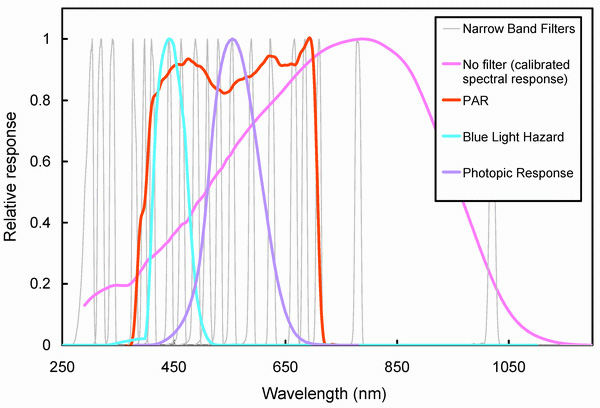The spectral response of a sensor is the magnitude of the signal from a sensor as a function of wavelength of the incident radiation.
Spectral response is sometimes denoted “spectral response function.” Spectral Response refers to the magnitude of response as a function of wavelength of a radiometer. Most radiometers offered by Biospherical Instruments either have a PAR response or a 10 nm wide narrow-band response which, when combined with an array of similar photodetectors across the spectrum, forms a spectroradiometer.
Most of our radiometers measure with the spectral response of a silicon photodiode (wide-band response between 250 and 1100 nm). When the wavelength distribution of the source being measured is known, and the instrument utilizes a known response function calibration, the desired optical flux can be measured.

Our radiometers features a selection of different filter assemblies that modify the spectral response of a silicon photodiode (other photodiodes available as well). The instruments can also be ordered with a large selection of standard filters including narrow-band and PAR, as well as custom filters that mimic some physiological response function. Options include:
- Narrow-Band filters(~10 nm bandwidth) are normally used when the source distribution is known and typically confined to a small region, such as a laser, or where it is combined in an ensemble of radiometers spaced through the spectral region of interest, such that the entire spectrum can be reconstructed.
- PAR(Photosynthetically Active Radiation), which is confined to the 400–700 nm spectral region and is weighted with a quantum response, as opposed to most weighted spectral responses. Calibration units include moles/(cm2 s), einsteins/(cm2 s), and quanta or photons/(cm2 s), and their MKS variants.
- Blue Light Hazard, which is defined as the potential for a photochemical-induced retinal injury resulting from radiation exposure at wavelengths primarily between 400 nm and 500 nm.
- Photometric Response, which describes the perceived brightness to the human eye.
- Erythema, which describes the wavelength-dependent sensitivity of the human skin to sunburn.
